Impacts of record-breaking compound heatwave and drought events in 2022 China on vegetation growth
The frequency and intensity of heatwaves and droughts have increased globally in the past several decades and are likely to continue to grow with future global warming. In the summer of 2022, China experienced a series of record-breaking heatwaves and unprecedented low rainfall-induced droughts across much of China’s regions. Vegetation growth condition is an important indicator of the terrestrial ecosystem’s response to heatwaves and droughts. Therefore, it is urgent to evaluate the impacts of the 2022 summer record-breaking heatwaves and droughts on vegetation growth.
Dr. Wenfang Xu, an associate professor from South China Botanical Garden, Chinese Academy of Sciences, used a reanalysis of the meteorological dataset and multi-satellite vegetation dataset to study the heatwaves and droughts characteristics in China’s 2022 summer and their impacts on vegetation growth. This work confirmed that the 2022 concurrent heatwaves in China were more frequent and widespread than in the past (1979-2021). The heatwaves presented the greatest record for heatwave count, heatwave days, and cumulative intensity, especially in the Yangtze River basin, Tibetan Plateau, and Northern China. Moreover, heatwaves often occur with concurrent droughts. In addition, this work found heatwaves and droughts reduced vegetation growth over half of the vegetated areas in China, represented by the negative detrended anomalies of the Normalized Difference Vegetation Index (NDVI; 66.89%), Enhanced Vegetation Index (EVI; 58.68%), and contiguous solar-induced chlorophyll fluorescence (CSIF; 56.47%). This study strengthens the understanding of the divergent response of plants to drier and warmer extreme climates, which is essential for evaluating future extreme climates on the terrestrial carbon cycle.
This work has been published in Agricultural and Forest Meteorology (https://doi.org/10.1016/j.agrformet.2023.109799). Dr. Wenfang Xu is the first author, and co-authors include Prof. Juxiu Liu and Prof. Donghai Wu from South China Botanical Garden, Chinese Academy of Sciences; Prof. Philippe Ciais from Laboratoire des Sciences du Climat et de l’ Environnement (LSCE), France; Prof. Yao Zhang from College of Urban and Environmental Sciences, Peking University; Prof. Wenping Yuan (corresponding author) and Dr. Xiaosheng Xia from Sun Yat-sen University.
This study was ?nancially supported by the Key Project of the National Natural Science Foundation of China (31930072), the National Science Fund for Distinguished Young Scientists of China (41925001), the Young Scientists Fund of the National Natural Science Foundation of China (42201055), and South China Botanical Garden, Chinese Academy of Sciences (QNXM-202308).

Figure 1. Spatial distribution of climate classification when
considering the temperature-related in conjunction with precipitation-related Extremes.
The labeled nine colors with a plus label (i.e., “+”) in the upper right corner of
the legend indicate the regions that experienced warmer and drier climates simultaneously in the 2022 summer.

Figure 2. Spatial patterns of summer detrended anomalies of NDVI, EVI,
and CSIF in 2022. The inset black and grey color bar panel indicates the percentage
of the pixels with positive (i.e., “P”) and negative (i.e., “N”) detrended anomalies of
corresponding vegetation variables in China and regions with drier and warmer climate conditions, respectively. The plus labels (i.e., “+”)
present the regions that experienced warmer and drier climates simultaneously in the 2022 summer.
File Download: